Vanishing Act
Nine experts reveal their magic formulas for staying out of sight
Nine experts reveal their magic formulas for staying out of sight

By Hampton Bourne
Theyre the bane of waterfowlers in every state along all four flywaysthose days when the ducks and geese just seem nervous and dont want to commit. This can be especially frustrating with larger flocks, when there are lots of eyes evaluating your setup and one suspicious bird can foil the whole group.
When the hunting is tough, some of us look for anything to explain the birds reluctance to approach the decoysthe steam rising from a cup of coffee perhaps, the phases of the moon, or maybe that neon green duck call. And while an infinite number of factors could prevent ducks and geese from lowering their landing gear, wise waterfowlers focus on concealment. They are meticulous and calculated in their preparation, and they know how to stack the deck in their favor by properly hiding their blind, their boat, and themselves. Here, we asked experienced hunters from across the country to share some of their secrets for staying hidden from the all-seeing eyes of waterfowl.
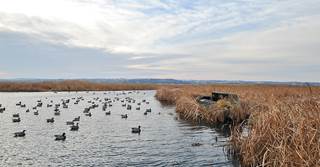
Photo Jim Thompson
Collin Trover is a throwback public-land waterfowler who is not afraid of hunting the hard way. He and his partners hunt from a boat in the marshes of western Kentucky. He says learning the marsh is crucial to their ability to hide.
Scouting and hunting experience are the two most important tools we have to conceal ourselves, Trover explains. We spend a lot of time learning waterfowl flight patterns and which parts of the marsh get the most traffic. Once we locate the flight patterns, we want to find the spots along those routes where we can hidespots that have overhead cover and vegetation in front of the boat. Those two features are critical for us. With that as our guide, we identify specific locations that we can hunt on different winds.
Youd be surprised how hard it is to locate a spot with overhead cover and enough low vegetation to hide the boat without pushing you out of shooting range. Find the places that offer both, and the birds will never see you. Find them on the flight patterns, and youll disappear right along the ducks pathway. But locating the spot that offers the perfect setup in the right place is easier said than done.
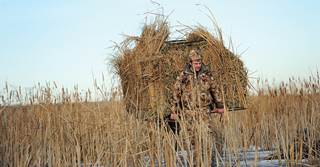
Photo Jim Thompson
Larger footprints certainly have their place, but Cal Burchett, a civil engineer by trade, prefers flying under the radar. Where we hunt, our goal is to be small, mobile, and natural, Burchett says. We hunt in flooded corn- fields out of five-person floating blinds. By using smaller blinds, we can move them to the parts of the hole where theyll be less noticeable based on hunting conditions.
We usually hide blinds in clumps of willows or maples and try to set up on the upwind side of the hole. The blinds smaller size allows us to hide in more places and gives us more flexibility to move instead of having to leave it in one spot. Plus, by the time ducks reach us in Middle Tennessee, theyve learned to associate big, square box blinds with hunters.
Another key aspect is making your blind comfortable, which can be tough with smaller blinds. We have found that the more comfortable hunters are, the less they move around. We try to build blinds with enough room to stretch, and we make sure we have comfortable chairs instead of a bench. The reduction of movement through the addition of comfort has dramatically reduced how many ducks see us.
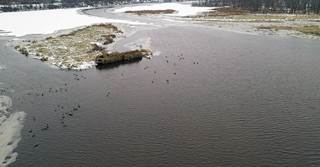
Photo Mossy Oak
Barnie Calef is a world champion duck caller and the owner of Calef Calls. He has hunted in Iowas public marshes for nearly 30 years, and today he prefers hiding his boat out in the open. Over years and years of trial and error, we have found that waterfowl, especially honkers, dont like landing directly into a backstop, like a brush pile or a woods line, Calef says. During hunting season, they become leery of areas where predators can hide. I think ducks and geese not only look at the decoys but past the decoys as well. Where theres a high backstop, theres no confirmation that predators arent around.
Instead of hunting up against a backstop with the wind at my back, I prefer a diagonal wind or a side wind without a backstop behind my boat blind so the birds can see behind and around the decoys. I just pull my boat into the smallest patch of grass or cattails I can find and stay very, very still. In a weird way, we hide right out in the open.
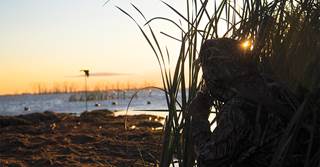
Photo Dean Pearson
Taylor Genz takes a contrarian approach to hiding in Saskatchewans cattail-lined potholes. Most people think you need a camo pattern that matches the vegetation where youre hiding. In reality, I want to blend in with the lowlights instead of the highlights, he explains.
In southeastern Saskatchewan, the cattail stands are light brown, similar to cornstalks. Its nearly impossible to match a camo pattern exactly to the cattails and other plant species around our potholes. Even if the colors match in a controlled environment, theres a big difference in the way fabric looks in sunlight compared to natural vegetation. If the colors look off to us, ducks will definitely take notice. Instead, I prefer to wear a darker camo pattern like Mossy Oak Bottomland and blend in with the shadows.
Darker camo patterns are the last thing people think about when trying to hide in lightly colored vegetation, but darker colors are more forgiving. When ducks circle prior to landing, they naturally look into the nearby edges that could hold predators. With lightly colored camo, I still stand out, even when hiding in the shadows. With darker patterns, I am nearly impossible to see.
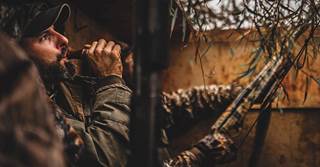
Photo Ed Wall Media
Rather than hiding in the shadows, professional guide and Mossy Oak Pro Staffer Bill Saunders prefers to eliminate them. A lot of people dont realize that shadows actually highlight your hide, Saunders says. Who lives in the shadows? The boogeyman. Shadows are places where predators, including humans, can hide.
Saunders eliminates shadows by completely covering the tops of his blinds. In southeastern Washington we hunt a lot of irrigated fields. In our pits we installed two-foot by two-foot drop-down doors that are flush mounted at ground level. We use rubber straps as hinges. I take the dirt around the pit to a paint store and color-match the lids to the ground.
When ducks or geese start coming, we drop into the pit, raise the doors from the inside, and completely close each shooting hole. We leave a very small crack in the doors, and shooters can only see the landing area. Instead of watching the birds, you have to listen to their calls and wing beats to determine where they are. When birds come into range, we silently drop the doors back into the pit and come up for the shot.
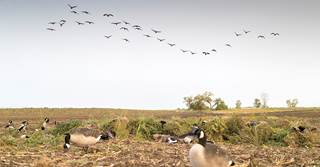
Photo Dean Pearson
Natural materials will always prevail when camouflaging a hide. Jeremy DeVries, a veteran guide and owner of River Rock Outfitters in Billings, Montana, has been besting waterfowl for three decades. I hunt rivers. Some days Ill hunt from a boat. Other days Ill hunt from a panel blind. But my favorite way to hunt public rivers is out of natural blinds that I build, DeVries says.
Every year in June and July I scout the rivers where I hunt and build natural blinds in holes that I think will hold waterfowl. Ill cut down four large branches from a cottonwood tree and bury them vertically several feet deep in a sandy bank or gravel bar. Then Ill lay another branch horizontally across the inside of the blind and lash it to the vertical limbs for added stability and functionality. Add some additional branches to fill in the frame, and theyll never know youre there.
For the most part, ducks will use the same areas year after year, so I build my blinds to last. After having built blinds for so many years, I now have a lot of different ones that I can hunt depending on weather conditions and the water levels on the rivers where I hunt. I know because of the work Ive put in over the years that Ill have a great hide regardless of the wind and sun.

Hiding in timber can be a challenge. J.C. Darby uses some sleight of hand to help focus wandering eyes whether hes hunting in his native South Carolina or traveling to waterfowling destinations as diverse as Arkansas or Ontario. In timber I try to build a temporary blind when I can, but thats not always possible, Darby explains. One thing I do religiously is incorporate some motion in the decoys. Sometimes we use spinning-wing decoys directly in the hole, but we also frequently set up a jerk string.
When ducks make a swing, Ill pull the jerk string to divert their eyes away from me. Also, I want my decoys to be in the sun, and as the sun rises and falls in the sky, I move my decoys so they look fresh and bright. With the added motion from the jerk string, it gives me a little more freedom to shift around the tree or prepare for a shot.
Knowing when to look up is one of the most important skills to learn when hunting timber. When ducks are swinging above you, theres no need to look at them. After they swing and start circling back, I check their positioning and give the jerk string a couple of pulls to create some motion they can see out of the corners of their eyes. It helps refocus their approach and gives me the freedom to adjust as needed.
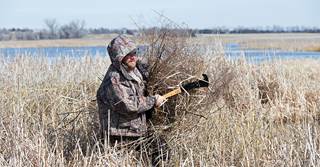
Photo Dan Witt
Camouflaging your blind can be one of the most important things you do in pursuit of waterfowl, but many hunters skip a crucial last step. Rich-N-Tones Jim Ronquest, who is based in Arkansas, recommends filling the holes. When a shooting hole is open in a duck blind, it looks like a big, black abyss, Ronquest says. Ducks overhead can see straight to the bottom of the blind, especially on cloudy days without shadows. Too many hunters fail to properly cover these holes.
We completely cover each shooting hole with oak brush. We also tie extra bundles of brush and lay them over the top of vacant shooting holes. Most people dont cover the holes enough because they think its a hassle to move around and shoot when the hole has a lot of cover on it. The nice thing about oak brush is that its leaves are broad enough to hide you, but you can still see through the gaps. When ducks come in and its time to come up for the shot, stand up in the hole by leading with your gun barrel. Your elbows will make a wedge and push the brush out of the way, and you wont have to worry about your gun getting caught in brush.

Photo DOUGSTEINKE.COM
Minnesota native and Molt Gear founder Scott Threinen believes in putting some distance between predator and prey. Whether Im hunting ducks or geese, I try to get out of the decoys, Threinen says. I dont want birds looking at me when they should be looking at the decoys. The farther I can get away from our decoys, the better. To determine that distance, I start with a one-to-10 scale to rate how favorable the habitat is for hiding. If the habitat is easy to hide in, like a cut cornfield with high stubble, I rank it a one. If the habitat exposes me, like a rolled soybean field would, I rank it a 10.
I multiply the hide number by three to determine how far to set up outside the decoys. If the hide is a 10, I want to be 30 yards from the decoys. If the hide is a one, I get three yards outside the decoys. Its the perfect way to be consistent once I know what works in an area. Ideally, I want to be set up in some natural shadows with the sun at my back and to avoid creating man-made shadows.
Ducks Unlimited uses cookies to enhance your browsing experience, optimize site functionality, analyze traffic, and deliver personalized advertising through third parties. By continuing to use this site, you agree to our use of cookies. View Privacy Policy